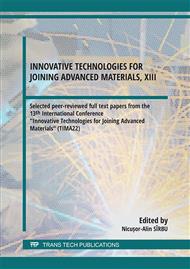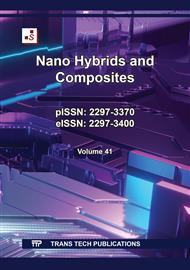[1]
Woosley, Smith, and Shyam Aravamudhan. "Functionally Modified Composites for FDM 3D Printing." (2022).
DOI: 10.5772/intechopen.104637
Google Scholar
[2]
Solomon, I. John, P. Sevvel, and J. Gunasekaran. "A review on the various processing parameters in FDM." MATER TODAY-PROC Vol.37 (2021), pp.509-514.
DOI: 10.1016/j.matpr.2020.05.484
Google Scholar
[3]
Mazzanti, Valentina, Lorenzo Malagutti, and Francesco Mollica. FDM 3D printing of polymers containing natural fillers: A review of their mechanical properties. ADV POLYM SCI 11.7 (2019), p.1094
DOI: 10.3390/polym11071094
Google Scholar
[4]
Akhoundi B, Behravesh AH and Bagheri Saed A. Improving mechanical properties of continuous fiber-reinforced thermoplastic composites produced by FDM 3D printer. J REINF PLAST COMP. Vol.38(3) (2019), pp.99-116
DOI: 10.1177/0731684418807300
Google Scholar
[5]
Garzon-Hernandez, S., et al. "Design of FDM 3D printed polymers: An experimental-modelling methodology for the prediction of mechanical properties." MATER DESIGN 188 (2020), p.108414
DOI: 10.1016/j.matdes.2019.108414
Google Scholar
[6]
Peng, Xingshuang, et al. "Investigation of processing parameters on tensile performance for FDM-printed carbon fiber reinforced polyamide 6 composites." Composites Communications 22 (2020), p.100478.
DOI: 10.1016/j.coco.2020.100478
Google Scholar
[7]
Peng, W. A. N. G., et al. "Effects of FDM-3D printing parameters on mechanical properties and microstructure of CF/PEEK and GF/PEEK." CHINESE J AERONAUT 34.9 (2021), pp.236-246
DOI: 10.1016/j.cja.2020.05.040
Google Scholar
[8]
Heidari-Rarani, M., et al. "Optimization of FDM process parameters for tensile properties of polylactic acid specimens using Taguchi design of experiment method." J THERMOPLAST COMPOS (2020), 0892705720964560
DOI: 10.1177/0892705720964560
Google Scholar
[9]
Dzienniak, Damian, and Jan Pawlik. "Analysis of the surface quality of polycaprolactam 3D prints enriched with carbon and glass fiber." MATEC WEB CONF. Vol. 338. EDP Sciences, (2021)
DOI: 10.1051/matecconf/202133801005
Google Scholar
[10]
Ranganathan, Soundararajan, et al. Analogy of Thermal Properties of Polyamide 6 Reinforced with Glass Fiber and Glass Beads through FDM Process. No. 2019-28-0137. SAE Technical Paper, (2019)
DOI: 10.4271/2019-28-0137
Google Scholar
[11]
Das, Diptikanta, et al. "Mechanical properties and abrasion behaviour of glass fiber reinforced polymer composites–A case study." MATER TODAY-PROC 19 (2019), pp.506-511
DOI: 10.1016/j.matpr.2019.07.644
Google Scholar
[12]
Sodeifian, Gholamhossein, Saghar Ghaseminejad, and Ali Akbar Yousefi. "Preparation of polypropylene/short glass fiber composite as Fused Deposition Modeling (FDM) filament." RESULTS PHYS 12 (2019), pp.205-222
DOI: 10.1016/j.rinp.2018.11.065
Google Scholar
[13]
Ng, N. Y. Z., et al. "Optimization of polyvinyl alcohol (PVA) support parameters for fused deposition modelling (FDM) by using design of experiments (DOE)." MATER TODAY-PROC 57 (2022), pp.1226-1234.
DOI: 10.1016/j.matpr.2021.11.046
Google Scholar
[14]
Boesch, Emilien, et al. "Impact of fused deposition modeling (FDM) process parameters on strength of built parts using Taguchi's design of experiments." Int. J. Adv. Manuf. Technol.101.5 (2019), pp.1215-1226
DOI: 10.1007/s00170-018-3014-6
Google Scholar
[15]
H. R. Mohan Kumar, Benal MGM, G S PK, Tambrallimath V, H R G, Khan TMY, Rajhi AA and Baig MAA. Influence of Short Glass Fibre Reinforcement on Mechanical Properties of 3D Printed ABS-Based Polymer Composites. POLYMERS-BASEL Vol.14(6) (2022), p.1182
DOI: 10.3390/polym14061182
Google Scholar
[16]
B. Akhoundi, A. Behravesh and A. B. Saed: Improving mechanical properties of continuous fiber-reinforced thermoplastic composites produced by FDM 3D printer J REINF PLAST Comp Vol. 38(3) (2019), pp.99-116
DOI: 10.1177/0731684418807300
Google Scholar



